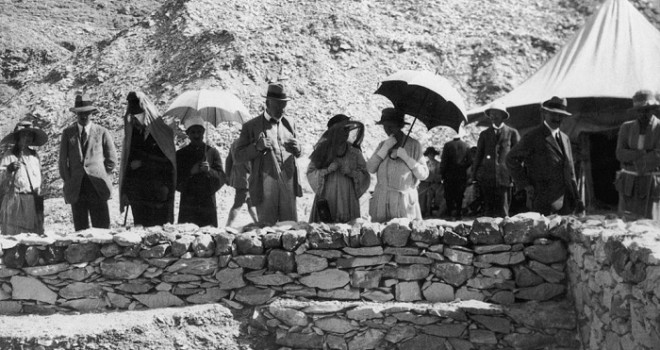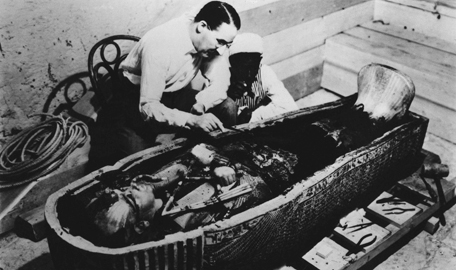La scoperta archeologica più evocativa: La tomba di Tutankhamon
Amici proseguiamo sulla falsa riga storico-misteriosa con la scoperta che, secondo me, rappresenta il culmine dell’archeologia egizia: La tomba di Tutankhamon.
Spesso le scoperte di questo livello sono associate a grandi personaggi, che sono, prima di tutto, dei sognatori e che spesso mettono a rischio tutto quel che hanno solo per una sensazione… Questo è quel che è capitato con questo incredibile ritrovamento datato 1922.
Vi spiego brevemente come andavano queste cose. Gli scavi erano affidati ad un archeologo ed alla sua equipe ma, chiaramente, i costi erano coperti da dei finanziatori che nel caso moderno sono spesso e volentieri statali mentre in passato era più comune la presenza di un mecenate ricco e spesso annoiato che voleva legare il suo nome ad una scoperta storica o semplicemente incrementare la sua collezione personale (spesso depredando i paesi di tesori inestimabili)…
In questo caso il finanziatore era George Edward conte di Carnarvon, un grande amatore di egittologia che nel 1907 si recò in Egitto intenzionato ad effettuare campagne di scavo per arricchire la propria collezione. Resosi conto della necessità di avere sul campo una persona esperta ed a conoscenza delle difficoltà della ricerca, chiese consiglio a Gaston Maspero che gli indicò come persona più adatta l’archeologo Howard Carter, all’epoca in forte difficoltà economica. Il duo così formatosi si legò non solo da un punto di vista lavorativo ma anche di amicizia sincera che portò alla più grande scoperta di questo tipo, ma che rischiò di mandare in banca rotta il conte che confidando nelle capacità di Carter investì somme sproporzionate.
Non dimenticate che ci fu una guerra di mezzo, il che rende l’impresa ancora più eclatante… Dopo cinque lunghi anni di ricerca infruttuosa il conte di Carnarvon era sul punto di gettare la spugna ma fu convinto dall’amico Carter a proseguire almeno per un altra ultima stagione ed il 4 novembre, il secondo giorno dopo l’avvio dei lavori, Carter trovò i gradini che conducevano alla tomba di Tutankhamon. Trasgredendo la norma che imponeva l’attesa del benestare degli addetti ai beni culturali egiziani, Carter praticò un pertugio nella parete.

Il conte si rivolse a Carter e gli chiese: «Riuscite a vedere qualcosa?» La risposta di Carter che ormai è storia fu: «Sì, cose meravigliose»
Ora avrete notato che in questo post non ho fatto cenno alle leggende che circolano sulla celebre tomba, perché a mio avviso ciò che di meraviglioso va raccontato è proprio nelle righe precedenti.
Volete vedere la tomba a 360 gradi? Eccovi il link: La tomba del re
The most evocative archaeological discovery: Tutankhamun’s tomb
Friends continue on the historical and mysterious line with the discovery that, in my opinion, is the culmination of Egyptian archeology: the tomb of Tutankhamun.
Often the discoveries of this level are associated with great characters, who are, first of all, dreamers and who often put at risk everything they have just for a feeling … This is what happened with this incredible find dated 1922 .
I’ll explain to you briefly how these things go. The excavations are entrusted to an archaeologist and his team but, clearly, the costs are covered by lenders who in the modern case are often willingly state while in the past it was more common the presence of a rich and often bored patron who wanted to tie the his name to a historical discovery or simply to increase his personal collection …
In this case, the lender was George Edward, Count of Carnarvon, a great lover of Egyptology who in 1907 went to Egypt intending to carry out excavation campaigns to enrich his collection. Realizing the need to have an expert on the field and aware of the difficulties of the research, he asked the advice of Gaston Maspero, who pointed out to him as the most suitable person the archaeologist Howard Carter, at the time in great economic difficulty. The duo thus formed was bound not only from a working point of view but also of sincere friendship that led to the greatest discovery of this type, but which threatened to break the count into bank that confided in the capabilities of Carter invested disproportionate sums.
Do not forget that there was a war between, which makes the company even more striking … After five long years of unsuccessful search the count of Carnarvon was about to throw in the towel but was convinced by his friend Carter to continue at least for another last season and November 4, the second day after the start of the work, Carter found the steps leading to the tomb of Tutankhamun. Transgressing the rule that required the approval of the employees of the cultural heritage of Egypt, Carter practiced a hole in the wall.

The count turned to Carter and asked, “Can you see anything?” Carter’s answer, which is now history, was: “Yes, wonderful things”
Now you have noticed that in this post I did not mention the legends that circulate on the famous tomb, because in my opinion what is wonderful to be told is in the previous lines.
Do you want to see the grave at 360 degrees? Here is the link: Tomb of the king
